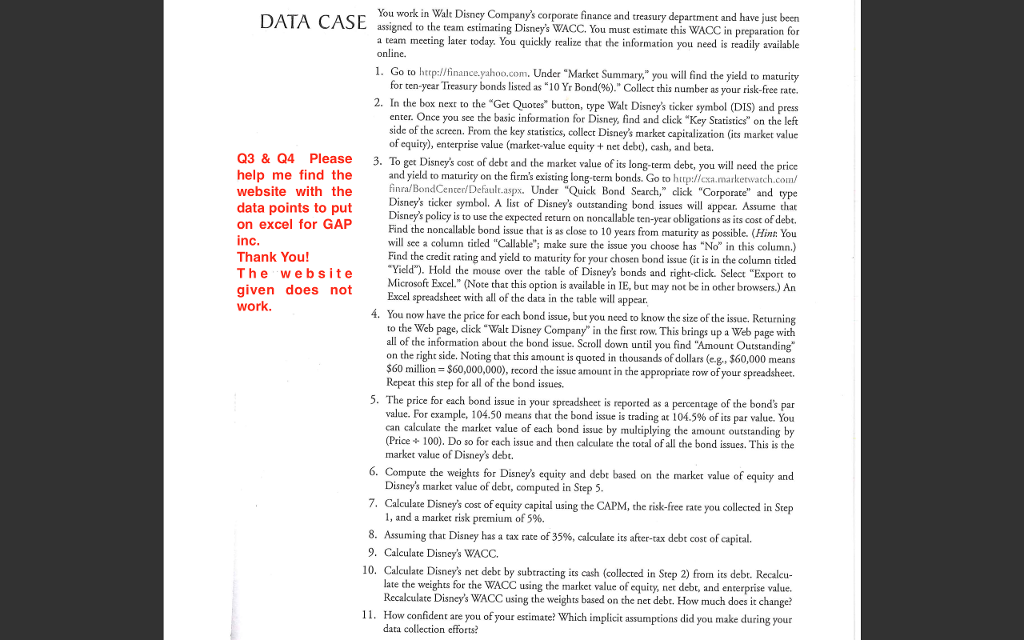
You work in Walt Disney Companys corporate finance and treasury department and have juse been assigned to the team estimating Disney's WACC. You must estimate this WACC in a team meeting later today. You quickly realize that the information you need is readily available online. DATA CASE preparation tor 1. Go to http:/finance.yahoo.com. Under "Market Summary," you will find the yield to maturity for ten-year Treasury bonds listed as "10 Yr Bond(%)." Collect this number as your risk-free rate. 2. In the box next to the "Get Quotes" button, type Walt Disney's ticker symbol (DIS) and press enter. Once you sce the basic information for Disney, find and click "Key Statistics" on the left side of the screen. From che key statistics, collect Disney's market capitalization (its market value of equity), enterprise value (market-value equitynet debt), cash, and beta. Q3 & Q4 help me find the website with the data points to put on excel for GAP inc Thank You! The website given does not work Please 3. To get Disney's cost of debe and the market value of its long-term debt, you will need the price and yield to maturicy on the firm's existing long-term bonds. Go to htrp:fexamarkerwatch.com/ finra/BondCencer/Default.aspx. Under "Quick Bond Search," click "Corporate" and type Disney's ticker symbol. A list of Disney's outstanding bond issues will appear. Assume that Disney's policy is to use the expected return on noncallable ten-year obligations as its cost of debt. Find the noncallable bond issue that is as close to 10 years from maturity as possible. (Hint: You will see a column ticled "Callable"; make sure the issue you choose has "No in this column.) Find the credit rating and yield to maturity for your chosen bond issue (it is in the column titled Yield"). Hold the mouse over the table of Disney's bonds and right click. Select "Export to Microsoft Excel." (Note that this option Excel spreadsheet with all of the data in the table will appear. You now have the price for each bond issue, but you need to know the size of the issue. Returning to the Web page, dlick "Walt Disney Company" in the first row. This brings up a Web page with all of the information about the bond issue. Scroll down until you find "Amount Outstanding on the right side. Noting chat this amount is quoted in thousands of dollars (eg, $60,000 means n is available in IE, but may not be in ocher browsers.) Arn 4. he issue amount in the appropriace row of your spreadsheet. Repeat this step for all of the bond issues. 5. The price for each bond issue in your spreadsheet is reported as a percentage of the bond's par value. For example, 104.50 means that the bond issue is trading at 104.5% of its par value. You can calculate the market value of each bond issue by multiplying the amount outstanding by (Price 100). Do so for each issue and then calculate the total of all the bond issues. This is the market value of Disney's debt. 6. Compute the weights for Disneys equity and debt based on the market value of equity and Disney's market value of debt, computed in Step 5 Calculate Disney's cost of equity capital using the CAPM, the risk-free rate you collected in Step 1, and a market risk premium of 5%. Assuming that Disney has a tax rate of 35%, calculate its after-tax debt cost of capital. Calculate Disney's WACC. 7. 8. 9. 10. Calculate Disney's net debt by subtracting its cash (collected in Step 2) from its debt. Recalcu- late che weights for the WACC using the market value of equity, net debt, and enterprise value. Recalculate Disney's WACC using the weights based on the net debt. How much does it change? How confident are you of your estimate? Which implicit assumptions did you make during your 11. data collection efforts? You work in Walt Disney Companys corporate finance and treasury department and have juse been assigned to the team estimating Disney's WACC. You must estimate this WACC in a team meeting later today. You quickly realize that the information you need is readily available online. DATA CASE preparation tor 1. Go to http:/finance.yahoo.com. Under "Market Summary," you will find the yield to maturity for ten-year Treasury bonds listed as "10 Yr Bond(%)." Collect this number as your risk-free rate. 2. In the box next to the "Get Quotes" button, type Walt Disney's ticker symbol (DIS) and press enter. Once you sce the basic information for Disney, find and click "Key Statistics" on the left side of the screen. From che key statistics, collect Disney's market capitalization (its market value of equity), enterprise value (market-value equitynet debt), cash, and beta. Q3 & Q4 help me find the website with the data points to put on excel for GAP inc Thank You! The website given does not work Please 3. To get Disney's cost of debe and the market value of its long-term debt, you will need the price and yield to maturicy on the firm's existing long-term bonds. Go to htrp:fexamarkerwatch.com/ finra/BondCencer/Default.aspx. Under "Quick Bond Search," click "Corporate" and type Disney's ticker symbol. A list of Disney's outstanding bond issues will appear. Assume that Disney's policy is to use the expected return on noncallable ten-year obligations as its cost of debt. Find the noncallable bond issue that is as close to 10 years from maturity as possible. (Hint: You will see a column ticled "Callable"; make sure the issue you choose has "No in this column.) Find the credit rating and yield to maturity for your chosen bond issue (it is in the column titled Yield"). Hold the mouse over the table of Disney's bonds and right click. Select "Export to Microsoft Excel." (Note that this option Excel spreadsheet with all of the data in the table will appear. You now have the price for each bond issue, but you need to know the size of the issue. Returning to the Web page, dlick "Walt Disney Company" in the first row. This brings up a Web page with all of the information about the bond issue. Scroll down until you find "Amount Outstanding on the right side. Noting chat this amount is quoted in thousands of dollars (eg, $60,000 means n is available in IE, but may not be in ocher browsers.) Arn 4. he issue amount in the appropriace row of your spreadsheet. Repeat this step for all of the bond issues. 5. The price for each bond issue in your spreadsheet is reported as a percentage of the bond's par value. For example, 104.50 means that the bond issue is trading at 104.5% of its par value. You can calculate the market value of each bond issue by multiplying the amount outstanding by (Price 100). Do so for each issue and then calculate the total of all the bond issues. This is the market value of Disney's debt. 6. Compute the weights for Disneys equity and debt based on the market value of equity and Disney's market value of debt, computed in Step 5 Calculate Disney's cost of equity capital using the CAPM, the risk-free rate you collected in Step 1, and a market risk premium of 5%. Assuming that Disney has a tax rate of 35%, calculate its after-tax debt cost of capital. Calculate Disney's WACC. 7. 8. 9. 10. Calculate Disney's net debt by subtracting its cash (collected in Step 2) from its debt. Recalcu- late che weights for the WACC using the market value of equity, net debt, and enterprise value. Recalculate Disney's WACC using the weights based on the net debt. How much does it change? How confident are you of your estimate? Which implicit assumptions did you make during your 11. data collection efforts







